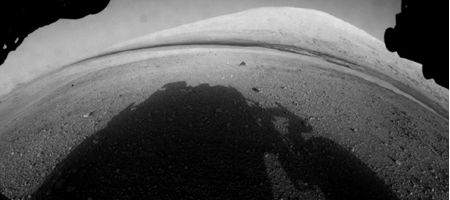Stunning images are already being beamed back from the Curiosity Mars rover as it undergoes a series of health checks before beginning its mission of exploration.

The 297 color, low-resolution images, taken by the onboard Mars Descent Imager, or MARDI, show the rover’s descent into Gale Crater.
But they’re only the tip of the iceberg: another 1,200-odd images still reside in the rover’s onboard memory. When put together in highest resolution, they’ll form a video showing the rover’s descent from the moment the entry system’s heat shield is released through touchdown.
“The image sequence received so far indicates Curiosity had, as expected, a very exciting ride to the surface,” says Mike Malin, imaging scientist for the Mars Science Lab mission from Malin Space Systems in San Diego.
“But as dramatic as they are, there is real other-world importance to obtaining them. These images will help the mission scientists interpret the rover’s surroundings, the rover drivers in planning for future drives across the surface, as well as assist engineers in their design of forthcoming landing systems for Mars or other worlds.”
The MARDI camera is located on the chassis of the Curiosity rover. One of the earliest images (above) shows the entry vehicle’s heat shield just three seconds after separation, 50 feet away and falling. The sequence continues right up to landing.
The images downlinked so far are low-resolution thumbnails, 192 by 144 pixels. “A good comparison is to that grainy onboard film from Apollo 11 when they were about to land on the moon,” said Malin.
But in the coming months, as communications between the rover and Earth become more robust, full-frame images 1,600 by 1,200 pixels in size, are expected to provide the most complete and dramatic imagery of a planetary landing in the history of exploration.
The mission’s also released a higher-resolution Hazcam image of its target, the mountain in the middle of Gale Crater informally titled Mount Sharp.

Now, Curiosity is checking its health and measuring its tilt. Everything sems to be working as planned so far,including the firing of all its pyrotechnic devices for releasing post-landing deployments.
Curiosity’s also checked out its UHF telecommunications system and rover motor controller assembly, and is now ready to get on with its mission.
The next step is what’s termed charactization activity, a one-month phase during which Curiosity’s high-gain antenna will be deployed and science data collected from the Radiation Assessment Detector and Rover Environmental Monitoring Station instruments.






